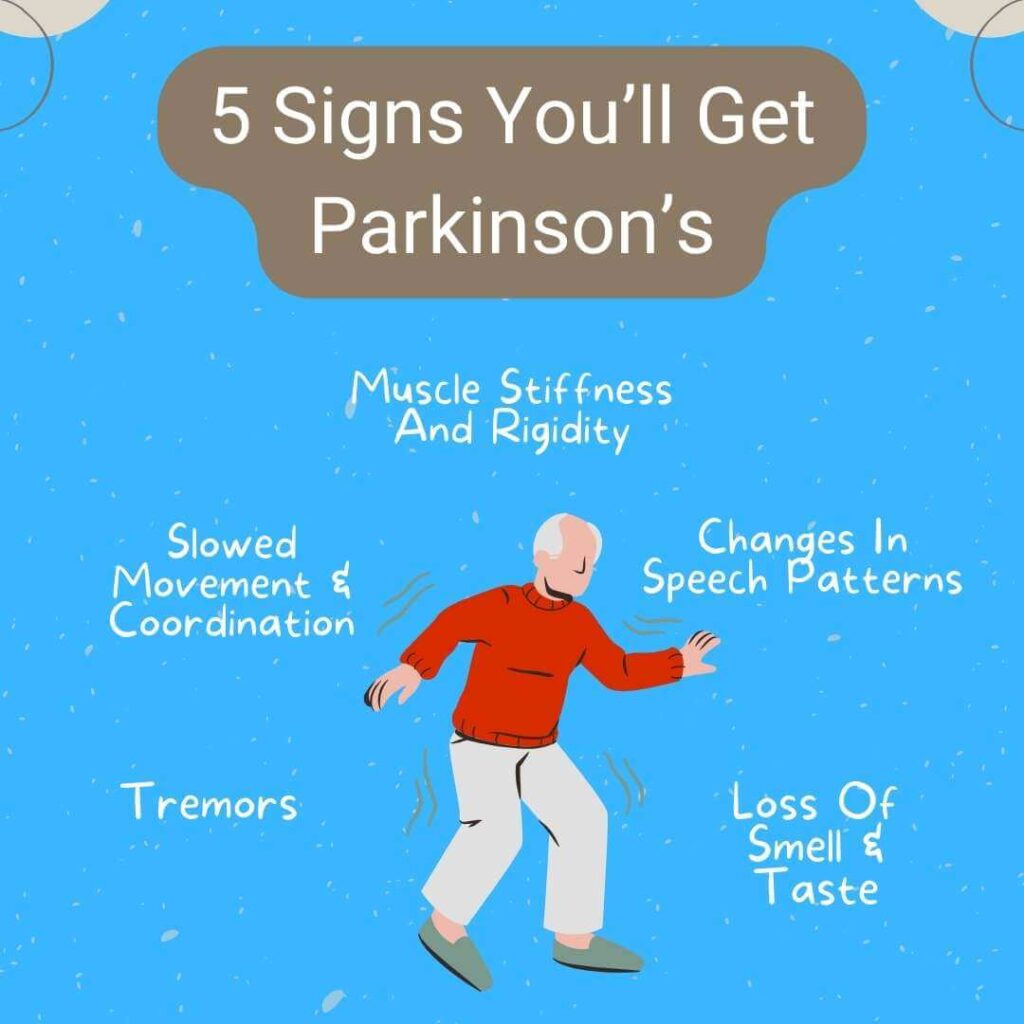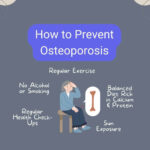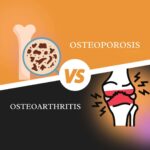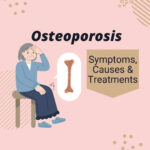Parkinson’s disease is characterized by the gradual loss of dopamine-producing cells in the brain, leading to various motor and non-motor symptoms. Recognizing the 5 signs you’ll get Parkinson’s can help individuals seek appropriate medical advice and access necessary treatment options promptly.

5 signs you’ll get Parkinson’s
1. Tremors: An Unsettling Shake
One of the most common early signs of Parkinson’s disease is tremors, particularly in the hands or fingers. These involuntary shaking movements can be subtle at first but gradually worsen over time. It often starts on one side of the body and progresses to both sides as the disease advances. These tremors can make simple tasks such as writing or holding objects challenging for individuals with Parkinson’s.
In addition to tremors, individuals with Parkinson’s disease may experience cramped handwriting, a condition known as micrographia. This occurs due to the progressive loss of fine motor control and coordination. As the disease advances, writing becomes increasingly small and difficult to read.
2. Slowed Movement and Coordination Difficulties
Another key indicator in the early stages of Parkinson’s is slowed movement, known as bradykinesia, along with difficulties in coordination. Patients may notice a general slowness in their daily activities, from walking to performing routine tasks like buttoning a shirt or tying shoelaces. This decrease in mobility can be frustrating and impact one’s independence. Difficulty walking such as dragging your feet as you walk can be a sign of Parkinson’s.
3. Muscle Stiffness and Rigidity
Muscle stiffness and rigidity are also common early symptoms experienced by individuals with Parkinson’s disease. The muscles become tense and inflexible, causing discomfort and limiting range of motion. This stiffness can affect various parts of the body, including arms, legs, neck, or even facial muscles. As a result, simple actions like turning around or getting out of bed become arduous tasks. Limited facial expressions, also called facial masking, are another result of this.
4. Changes in Speech Patterns
Parkinson’s disease often affects speech patterns as well. Individuals may notice changes such as a softening of voice, slurring, or a monotonous tone. These alterations can make communication challenging and lead to misunderstandings or social withdrawal. Being aware of these vocal changes can help identify the presence of Parkinson’s disease in its early stages.
5. Loss of Smell and Taste
Surprisingly, a diminished sense of smell or changes in taste can be early indicators of Parkinson’s disease. Many individuals with Parkinson’s report a reduced ability to detect odors or experience alterations in their perception of taste. While this symptom may seem unrelated, it has been observed that olfactory dysfunction often precedes the motor symptoms associated with Parkinson’s disease.
Nonmotor Symptoms of Parkinson’s Disease
The most prominent symptoms of PD are motor symptoms. However, nonmotor symptoms also can help with the detection of Parkinson’s.
- Depression and anxiety are common nonmotor symptoms that often accompany the physical manifestations of the disease. Individuals with Parkinson’s may experience feelings of sadness, hopelessness, and a lack of interest in activities they once enjoyed.
- Sleep Disturbances: Insomnia, characterized by difficulty falling asleep or staying asleep throughout the night. In some cases, individuals with Parkinson’s may experience REM sleep behavior disorder (RBD), a condition where people act out vivid dreams physically during REM sleep. This disorder can result in potentially dangerous situations for both the individual and their sleeping partner.
- Cognitive changes such as memory loss or difficulty concentrating affect many patients of Parkinson’s. These symptoms may manifest as forgetfulness, struggling to recall recent events or conversations, or an overall decline in cognitive performance.
- Constipation: The slowing down of movement throughout the digestive tract can lead to difficulties in passing stools, resulting in constipation.
When to See a Doctor
If you’re concerned about your health and suspect that you may be experiencing symptoms based on the 5 signs you’ll get Parkinson’s, it’s crucial to seek medical attention as soon as possible. In our blog, we explain in detail How Parkinson’s Is Diagnosed.
While only a healthcare professional can provide an accurate diagnosis, there are several signs that should prompt you to schedule an appointment with a doctor.
- Persistent Tremors: If you notice these tremors persisting for an extended period, it’s essential to consult a doctor. While not all tremors indicate Parkinson’s disease, they should still be evaluated by a healthcare professional to rule out any underlying conditions.
- Unexplained Muscle Stiffness or Rigidity: If you find yourself experiencing unexplained muscle stiffness that affects your day-to-day activities, it is advisable to seek medical attention.
- Changes in Speech Patterns: If you notice changes in your speech patterns such as slurring words or difficulty pronouncing certain sounds consistently, consulting a healthcare professional is recommended. They will be able to evaluate your condition and provide appropriate guidance.
- Loss of Smell or Taste: If you find yourself unable to detect certain scents or experience a diminished sense of taste that persists over time, it is advisable to consult with a healthcare professional.
Causes and Risk Factors of Parkinson’s Disease
The exact cause of Parkinson’s disease is still unknown, but researchers have identified several factors that contribute to its development. Both genetic and environmental factors play a role in the onset of this neurodegenerative disease.
- Age is one of the most significant risk factors for Parkinson’s disease is age. The majority of cases occur after the age of 60, although it can develop at any age.
- Exposure to Toxins: Pesticides, in particular, have been extensively studied in relation to this condition. Long-term exposure to these chemicals has been found to elevate the risk significantly.
- Genetic Predisposition: Family history also plays a role in an individual’s likelihood of developing Parkinson’s disease. Having a close relative with the condition increases one’s chances of being affected as well.
Available treatments for Parkinson’s disease
Medications like levodopa help manage motor symptoms
Levodopa is a widely used medication for treating Parkinson’s disease (PD). It is a form of dopamine, a chemical that plays a crucial role in transmitting signals between nerve cells in the brain. Levodopa works by converting into dopamine in the brain, helping to alleviate the motor symptoms associated with PD.
The use of levodopa can significantly improve muscle rigidity, tremors, and bradykinesia (slowness of movement), allowing individuals with PD to regain control over their movements. This medication has been extensively studied and has shown remarkable efficacy in managing these motor symptoms.
It is important to note that while levodopa provides significant relief, its effectiveness may diminish over time as the disease progresses. This phenomenon, known as “wearing off,” may require adjustments in dosage or the addition of other medications to maintain symptom control. Regular follow-ups with healthcare professionals are essential to optimize treatment outcomes.
Physical therapy can improve mobility and reduce muscle stiffness
Physical therapy plays an integral role in managing Parkinson’s disease by improving mobility and reducing muscle stiffness. A skilled physical therapist can design an exercise program tailored to each individual’s needs and abilities.
Moreover, physical therapy can address specific challenges faced by people with PD such as freezing episodes or difficulties initiating movements. Therapists employ various techniques like cueing strategies or visual aids to overcome these obstacles effectively.
Deep brain stimulation is a surgical option for symptom control
Deep brain stimulation (DBS) is a surgical treatment option that can provide significant relief from the symptoms of Parkinson’s disease. It involves implanting electrodes into specific areas of the brain responsible for motor control. These electrodes deliver electrical impulses to modulate abnormal neuronal activity and alleviate PD symptoms.
DBS is typically recommended for individuals who have experienced a positive response to levodopa but are facing complications due to medication side effects or fluctuations in symptom control. It can effectively manage motor symptoms such as tremors, rigidity, and dyskinesias.
Key Takeaways from Early Warning Signs of Parkinson’s Disease
Tremors, slowed movements, muscle stiffness, speech changes, and loss of smell/taste are the key indicators of Parkinson’s.
Early detection plays a crucial role in managing Parkinson’s disease effectively. By identifying the warning signs early on, healthcare professionals can provide appropriate treatment plans tailored to each individual’s needs. This may involve a combination of medication, physical therapy exercises aimed at improving mobility and flexibility, occupational therapy techniques to enhance daily activities’ performance, and speech therapy interventions targeting communication difficulties.
Common questions about Parkinson’s disease symptoms
It is crucial to remember that if you or someone you know is experiencing any potential symptoms of Parkinson’s disease, it is essential to consult with a healthcare professional for an accurate diagnosis and appropriate treatment plan.
FAQs about Parkinson’s Disease Symptoms
Can stress worsen Parkinson’s symptoms?
Stress can potentially exacerbate certain symptoms of Parkinson’s disease, such as tremors or muscle stiffness. It is advisable for individuals with Parkinson’s to manage stress levels through techniques like relaxation exercises, mindfulness practices, or seeking support from therapists or support groups.
Are there any natural remedies that can alleviate Parkinson’s symptoms?
While there is no cure for Parkinson’s disease, some individuals find relief from certain complementary therapies like acupuncture or massage therapy. However, it is essential to consult with a healthcare professional before trying any alternative treatments to ensure they are safe and suitable for your specific situation.
Does everyone with early warning signs of Parkinson’s develop full-blown symptoms?
Not everyone who experiences early warning signs of Parkinson’s will necessarily develop full-blown symptoms of the condition. Some individuals may only exhibit mild symptoms that progress slowly over time, while others may not progress beyond initial warning signs.
Can genetics play a role in developing Parkinson’s disease?
Yes, genetics can contribute to an increased risk of developing Parkinson’s disease in some cases. However, it is important to note that having a genetic predisposition does not guarantee the development of the condition. Environmental factors and other variables also play a significant role.
Is Parkinson’s disease more common in men or women?
Parkinson’s disease affects both men and women, but studies suggest that it may be slightly more prevalent in men. However, further research is needed to fully understand the potential gender differences in the occurrence and progression of Parkinson’s disease.
References
https://medlineplus.gov/genetics/condition/parkinsons-disease/
https://www.nia.nih.gov/health/parkinsons-disease
- How To Improve Gut Microbiome – 26 May 2024
- Chemo neuropathy treatment: What to do? – 19 May 2024
- How to Prevent Osteoporosis: Effective Strategies & Simple Steps – 28 December 2023





